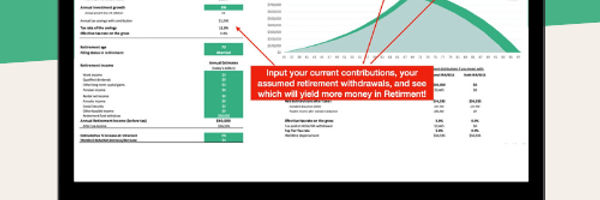A poorly performing economy often forces people to look for short term sources of much needed cash. That's one of the reasons selling pension benefits is growing in popularity. But before entering into any agreement to sell a pension, it's important to understand the real cost of these loans. In this article, we're going to talk about pension selling programs. As part of that discussion, we'll differentiate between retirement income and loans. Next, we'll describe the typical structure of these deals, eligibility, and the life insurance requirements that may be placed on pensioners. Finally, we'll summarize the pros and cons of a sale, and talk about some very viable alternatives.

Roth IRA or 401k? This template will answer your questions.
With this template, you will get:
All DFY, simply add your details
Charts for comparison and clear answer
Easily update for any year (2023, 2024, 2025, etc…)

Retirement Pensions
The purpose of a pension is to provide a former employee with a reliable source of income once retired. Pensions are referred to as defined benefit plans because they guarantee the beneficiary a payout when retired. These monthly payouts are usually calculated using a combination of years of service and employee salary. Back in the 1990s, companies began moving away from offering a pension as part of their benefits programs. Instead, they began offering cash value plans, defined contribution plans, as well as self funding retirement programs such as the 401(k). Today, pension plans remain a popular benefit with unionized workforces. Teachers, police officers, fireman, military personnel, and the vast majority of state and federal employees continue to rely on pension plans to supply retirement income.
Pension Selling
Also known as pension loans, the concept of pension selling is very simple. The pensioner gives up a future stream of monthly income in exchange for an immediate onetime payment. The retiree may choose to do so because they place a greater value on the upfront payment of money than they do on a steady source of retirement income. For example, the retiree might want to:
Start a new business
Reduce outstanding credit card debt
Lump-Sums versus Buyouts
It's important to note that selling, or buying out, a pension is not the same concept as a lump sum payment. If offered, the option of taking a lump sum payment instead of a pension is typically provided to an employee by their company before they begin receiving monthly income from their pension. Lump sums can be thought of as the present value of all of the expected future payments a company will make to the employee. Lump sums are calculated using factors such as the employee's age and expected lifespan; to forecast the total future payments made to the employee or pension beneficiary. Such calculations are typically performed by an actuary.
The primary benefit of pension selling is receiving an upfront payment of cash, which can then be used to pay for an immediate need such as a medical procedureMoneyzine Editor
Lump sums are normally offered as a onetime option and involve giving up all future pension payments. Once a stream of income is received from a pension, it's usually not possible to convert to a lump sum. Pension selling allows the retiree to convert a portion of their future stream of income into an upfront payment.
Loan Process
Companies offering pension loans require very little information before they are willing to provide a quote. In addition to the routine contact information (name, address), these companies will want to know:
The company providing the pension
Age of pensioner
Payment process (electronic or mailed check)
The amount received each month
How much money is needed, and how the money will be used
Life Insurance
Even if a retirement pension has a survivor clause, it is very likely the pension loan company will require the applicant to prove they have an active life insurance policy. If the pensioner were to pass away before the term of the agreement were to expire, then the monthly income stream from the pension would stop. To eliminate the risk of non-payment, the proceeds from the insurance policy would be used to pay off any remaining balance on the pension loan. If the applicant does not have life insurance, the lender will help establish a policy as part of the approval process. If the loan is of a term of 12 months or less, the life insurance requirement may be waived.
Eligibility Rules
In addition to the life insurance requirement, there may also be a monthly pension minimum threshold. For example, the applicant may be required to have at least $500 in monthly pension income to be eligible for a buyout. Federal programs do not qualify as pension income. Recipients of Social Security or veterans receiving VA Disability Compensation cannot use the money from these programs to qualify for a buyout loan. A recent bankruptcy may also limit eligibility.
Loan Terms and Interest Rates
Typical loan terms range from 12 months to six years. As described above, selling a pension is akin to taking out a loan and using the monthly pension payments to pay down the loan's principal balance. Using the retiree's monthly pension income value and the desired upfront payment, the pension buyout firm will determine the percentage of the monthly income needed to pay off the loan in the chosen timeframe. For example, suppose a retiree would like an upfront payment of $10,000 and has $2,000 in monthly income from their pension. If the retiree chooses a 12-month timeframe to repay the loan, the pension buying firm might require a payment of roughly $1,000 per month, or 50% of the monthly pension value. Most firms will be unwilling to accept more than 85% of the net monthly pension income amount. The calculated interest rates on these loans are quite high. The exact interest rates charged are not indicated on marketing materials, but the implied rate can be calculated. For example, typical offerings in the marketplace specify a $6,000 loan over 12 months requires a payment of $650 per month. This works out to an annual percentage rate of 51.4%. Six-year payback scenarios offer more attractive rates. For example, a $29,000 loan over six years requires a payment of roughly $800 per month. This works out to an annual percentage rate of 26.1%.
Pros and Cons
The primary benefit of pension selling is the ability to receive an upfront payment of cash. This money can then be used to pay for an immediate need such as a down payment on a car or to finance a medical procedure. Unfortunately, this benefit comes at a high cost. The disadvantages of selling a pension are significant. If the pension income is needed to pay monthly household bills, an alternate source of income will be needed until the term of the arrangement expires. This means the retiree will need to find a new job, which may be difficult for seniors. Another disadvantage of these loans is the interest rates charged. As demonstrated above, the interest rates applied to these loans are extremely high, over 50% in some instances.
Alternatives
Given the high cost of pension selling, the logical alternative is to apply for a loan from a more traditional lending institution such as a local bank or credit union, using the same monthly pension income to pay off this traditional loan. If debt is a problem, then a credit counselor should be able to help balance a home's budget and begin the process of paying down debt. Finally, and after careful investigation into the company's background, a reverse mortgage may be helpful if the retiree has significant equity in their home.





